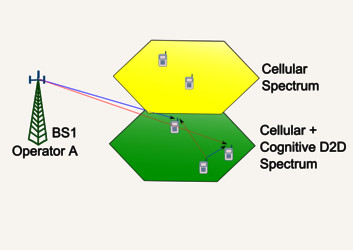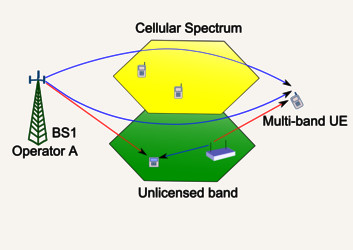Cognitive Mobile Radio
A cognitive radio identifies the vacant spectral resources of an existing system (primary system) and exploits these opportunities for its communication. Identification of suitable spectral resources is achieved either by sensing or through the use of databases that records the activity of the primary system. The quality of service (QoS) of a cognitive radio system therefore depends on the primary system load. Until recently, this fact has discouraged the use of cognitive radio for cellular systems. Future cellular technologies such as 3GPP LTE-A, allows carrier aggregation where a base station is able to transmit over several component carriers. A subset of these component carriers will be exclusively owned by the respective operator (i.e, unshared), thereby enabling the operator to provide QoS guarantees. The remaining pool of carriers can then be shared between different operators using a cognitive approach. Such an approach is expected to be highly beneficial in the following contexts.
- Spectrum sharing between operators (Figure 1): An operator with low system load is able to sell a portion of the spectrum to another operator who is in need for spectrum.
- Enabling cognitive device-to-device (D2D) communications (Figure 2): A base station can enable direct communication between devices without a significant impact on the communications between the base station and the mobile stations.
- Harness the capacity of unlicensed bands (Figure 3): A base station can aggregate unlicensed carriers to provide a supplementary data channel to multi-band users thereby increasing their data rates.



Topics of research include
- Sensing for primary system activity before transmission (Listen before talk) as well as during communication (Listen while talk).
- Transmission schemes to avoid interference to the primary system and reception schemes for suppressing interference, especially in underlay systems.
- Protocols for transmission and sensing.
- System level characterization of different approaches.
- Coexistence issues between WiFi and LTE-A in unlicensed bands etc.
